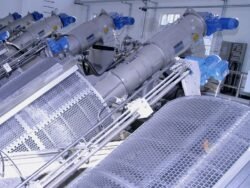Biological Treatment for Wastewater: An In-Depth Analysis
Introduction
As global populations swell and industrial activities intensify, the importance of effective wastewater management is more critical than ever. Wastewater treatment systems are pivotal in protecting human health and preserving our environment. Among various treatment methods, biological treatment stands out for its sustainability, cost-effectiveness, and efficiency in removing organic pollutants. This article delves deep into biological wastewater treatment, providing a comprehensive overview that highlights its mechanisms, types, advantages, challenges, and future prospects, establishing a strong foundation to address a key question: How can biological treatment solutions improve wastewater management in an increasingly complex world?
Understanding Biological Treatment: The Basics
What is Biological Treatment?
Biological treatment involves utilizing biological organisms, primarily bacteria, to decompose organic compounds found in wastewater. This process occurs under controlled conditions in various systems, effectively reducing sludge volume while enabling the conversion of contaminants into harmless byproducts. Understanding this mechanism is integral to mastering wastewater treatment technologies.
Mechanism of Biological Treatment
The biological treatment process can be divided into two fundamental mechanisms: aerobic and anaerobic treatment.
-
Aerobic Treatment: This method involves the use of oxygen-dependent bacteria that thrive in the presence of oxygen. As they consume organic matter, these bacteria oxidize pollutants, producing carbon dioxide, water, and biomass. Aerobic treatment is widely utilized in activated sludge processes and biological aerated filters.
- Anaerobic Treatment: Anaerobic bacteria, on the other hand, function in environments devoid of oxygen. These microorganisms decompose organic matter through fermentation, releasing methane, carbon dioxide, and residual organic material. Anaerobic digestion is particularly effective in treating high-strength wastewater, such as that from food processing industries.
Key Statistics: According to recent industry analyses, approximately 70% of municipal wastewater treatment facilities employ biological treatment as part of their processes, highlighting its widespread adoption and trust within the wastewater treatment sector.
Types of Biological Treatment Processes
A variety of biological treatment systems exist, each tailored to specific wastewater characteristics and treatment goals. Below we outline several prevalent methods.
1. Activated Sludge Process
The activated sludge process is one of the most commonly used methods for wastewater treatment. This system employs microorganisms to decompose organic matter as it passes through aeration tanks. The process can be broken down into the following stages:
-
Aeration: Wastewater enters the aeration tank and is mixed with activated sludge, which contains a high concentration of microorganisms. Air is introduced to facilitate the growth of aerobic bacteria.
-
Settling: After a predetermined retention time, the mixture flows to a clarifier where biomass settles out as sludge, allowing treated water to be discharged.
- Return and Waste Sludge: A portion of the settled sludge is returned to the aeration tank to maintain the microbial population, while excess sludge is removed for further treatment.
2. Biofilm Systems
Biofilm systems, such as trickling filters and membrane bioreactors, utilize microorganisms that attach to surfaces. Here’s a brief look into these systems:
-
Trickling Filters: Wastewater is distributed over a bed of media (rocks, plastic, or other materials) where biofilms form. As water trickles down, microorganisms degrade organic matter.
- Membrane Bioreactors (MBRs): Combining biological treatment with membrane filtration, MBRs provide high-quality effluent while allowing higher microbial retention, thus enhancing treatment efficiency.
3. Constructed Wetlands
Constructed wetlands mimic natural wetland processes. They incorporate aquatic plants, soil, and other natural materials to treat wastewater. They operate on principles of filtration, adsorption, and microbial action, efficiently removing pollutants.
- Benefits: Constructed wetlands are a sustainable option, requiring minimal energy and providing benefits like habitat for wildlife.
4. Anaerobic Digestion
Anaerobic digestion is particularly efficient for high-strength waste, such as food waste. Under anaerobic conditions, microbes decompose organic matter, producing biogas (mostly methane) that can be harnessed as renewable energy.
Advantages of Biological Treatment
Biological treatment processes offer numerous advantages over chemical and physical methods. These include:
1. Cost-Effectiveness
Biological treatment typically involves lower operational costs. Research published in environmental engineering journals indicates that biological processes can reduce treatment costs by 30% compared to traditional chemical methods, primarily due to reduced energy and chemical inputs.
2. Environmental Benefits
Biological systems significantly lower harmful pollutants, promoting a more sustainable approach. They contribute to reduced greenhouse gas emissions and can recover energy in the form of biogas, aligning with the circular economy model.
3. Versatility and Scalability
Biological treatment systems are adaptable to various scales—from small-scale decentralized systems suitable for rural areas to large-scale municipal plants capable of treating millions of gallons per day.
4. Effective Removal of Organic Pollutants
According to studies, biological treatment can achieve up to 95% removal efficiency for biochemical oxygen demand (BOD) and total suspended solids (TSS), positioning it as a robust option for wastewater treatment.
Challenges in Biological Treatment
Despite its advantages, the biological treatment process does face several challenges:
1. Process Control and Stability
Biological systems are sensitive to fluctuations in wastewater composition (e.g., temperature, pH, and pollutant loads). Changes can affect microbial performance, requiring rigorous monitoring and control measures.
2. Sludge Management
Excess sludge from biological treatment processes can pose disposal challenges. Proper management strategies, including thickening, stabilization, and dewatering, are necessary to mitigate this issue.
3. Pathogen Removal
Ensuring effective pathogen removal can be problematic in biological systems. Therefore, post-treatment processes or additional disinfection may be necessary to meet regulatory requirements.
Future Trends in Biological Treatment
The evolution of biological treatment technology continues, driven by innovation and the quest for sustainability.
1. Advancements in Genetic Engineering
Genetic modifications in microbes could enhance their performance, enabling them to target specific contaminants or operate efficiently under challenging conditions.
2. Integration of Renewable Energy Solutions
A growing trend is the integration of renewable energy technologies (e.g., solar or wind) in biological treatment facilities, further decreasing reliance on fossil fuels and enhancing sustainability.
3. Smart Water Management Systems
The incorporation of IoT (Internet of Things) technologies in treatment plants is transforming operations. Smart sensors can track real-time data, automate processes, and optimize biological treatment efficiency.
Conclusion
Biological treatment stands as a testament to nature’s ingenuity in addressing one of our most pressing environmental challenges—wastewater management. Through anaerobic and aerobic mechanisms, diverse systems, and a commitment to sustainable practices, biological treatment offers powerful solutions for effectively managing wastewater. As technological advancements unfold and environmental challenges intensify, embracing biological treatment could be pivotal in ensuring a cleaner, safer future for our water resources. It is incumbent upon wastewater treatment professionals and facility managers to remain vigilant, informed, and adaptable to harness these solutions in the face of a dynamic global climate.
FAQs
1. What type of wastewater can biological treatment effectively treat?
Biological treatment is effective for various types of wastewater, including municipal sewage, industrial effluents, and agricultural runoff, particularly those with a high concentration of organic matter.
2. How can I implement biological treatment in my wastewater management strategy?
Consult with wastewater management experts to assess the specific characteristics of your wastewater, and consider a pilot study to evaluate the feasibility of biological treatment options.
3. Are there regulatory requirements I need to be aware of for biological treatment systems?
Yes, it’s essential to review local, state, and national regulations governing wastewater treatment processes, including permit requirements and effluent discharge standards.
4. Is biological treatment suitable for small-scale applications?
Absolutely! Techniques like constructed wetlands and small-scale aerobic treatment units can be deployed in rural or remote areas where conventional treatment facilities are not feasible.
In summary, biological treatment for wastewater presents a pragmatic approach aligned with sustainable development goals, ensuring cleaner water and a healthier planet for future generations.
source https://www.waterandwastewater.com/biological-treatment-for-wastewater/



No comments:
Post a Comment